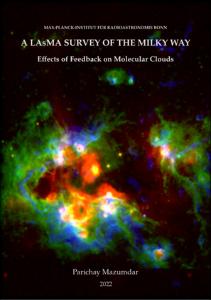A LAsMA Survey of the Milky WayEffects of Feedback on Molecular Clouds

A LAsMA Survey of the Milky Way
Effects of Feedback on Molecular Clouds

| dc.contributor.advisor | Menten, Karl M. | |
| dc.contributor.author | Mazumdar, Parichay | |
| dc.date.accessioned | 2022-09-02T07:01:12Z | |
| dc.date.available | 2022-09-02T07:01:12Z | |
| dc.date.issued | 02.09.2022 | |
| dc.identifier.uri | https://hdl.handle.net/20.500.11811/10217 | |
| dc.description.abstract | The advent of radio and (sub) millimetre astronomy has opened the world of molecular clouds (MCs) to astronomers' wonder. At the turn of the 21st century, MC surveys have helped us better understand them. How MCs form, their morphology, physical conditions, and many other aspects are active research areas. This dissertation takes another step toward understanding MCs by conducting the first large-scale high-resolution survey of giant molecular clouds (GMCs) in the Milky Way (LAsMAGal), covering 12CO and 13CO (3-2) lines simultaneously. Part I and II provide an overview of the background knowledge related to molecular clouds and the star-formation theory and introduce the new 7-pixel receiver (LAsMA) used for the survey. The commissioning tests done on the instruments are also presented in part II. In Part III, we examine if LAsMAGal is feasible and test observing strategies. The test observations showed 4 fold improvement in noise levels compared to the SEDIGISM 13CO (2-1) survey (the most relevant survey towards the planned region for LAsMAGal). Part IV presents LAsMAGal data towards the G305 star-forming GMC used to study feedback effects from the central cluster of OB stars. The distribution of CO excitation was compared to that of 8-micron emission imaged with Spitzer (dominated by UV-excited emission from polycyclic aromatic hydrocarbons). A 13CO J=3-2/2-1 (line ratio) excitation map was obtained by combining LAsMAGal and SEDIGISM data. Line profiles along radially outward directions showed a factor of 2-3 increase in gas excitation temperature as well as line ratio at the GMC edge facing the center of the complex. Excitation temperature, line ratio and column density showed a positive correlation with 8-micron flux. Centroid velocities and stacked line profiles were examined to investigate the feedback effect on gas dynamics. The velocity probability distribution function displayed exponential wings, indicating turbulence driven by strong stellar winds. Stacked spectra in regions with stronger feedback had higher skewness than regions with weaker feedback. Therefore, feedback from the stellar cluster in G305 shows demonstrable effects on the gas excitation and dynamics of the GMC. The next chapter investigates the effects of feedback on star formation in G305. First, the region is decomposed into clumps using dendrogram analysis. Their surface mass densities positively correlated with incident 8-micron flux. Clumps were categorized into "mostly inside" (> 67%), "partly inside" (< 10% and > 67%), and "outside" (< 10%) subsamples based on their overlap with an 8 micron flux mask. The 3 subsamples had a statistically significant difference in surface mass densities. The "mostly inside" subsample also showed the highest level of fragmentation proving G305 clumps are triggered. Then, G305 clumps were compared with the Galactic average taken from a distance-limited sample of ATLASGAL 870 mm dust continuum and CHIMPS 13CO (3-2) clumps. The G305 clump population was statistically different from the average Galactic population, ruling out redistribution due to feedback. Finally, the cumulative distribution functions (CDFs) of the clump masses and L/M ratios in G305 were compared to values of the Galactic sample. The CDFs were flatter in G305, indicating that clumps are heavier and more efficient at forming stars in G305, driving triggered star formation in this GMC. The final part of the thesis updates the current status of LAsMAGal. The reduction pipeline is also presented, followed by the maps of the regions observed so far. Finally, a summary of the work is given in the final chapter. | en |
| dc.language.iso | eng | |
| dc.rights | Namensnennung 4.0 International | |
| dc.rights.uri | http://creativecommons.org/licenses/by/4.0/ | |
| dc.subject | interstellar medium | |
| dc.subject | molecular clouds | |
| dc.subject | sub-millimeter astronomy | |
| dc.subject | stellar feedback | |
| dc.subject | stellar astrophysics | |
| dc.subject.ddc | 520 Astronomie, Kartografie | |
| dc.title | A LAsMA Survey of the Milky Way | |
| dc.title.alternative | Effects of Feedback on Molecular Clouds | |
| dc.type | Dissertation oder Habilitation | |
| dc.publisher.name | Universitäts- und Landesbibliothek Bonn | |
| dc.publisher.location | Bonn | |
| dc.rights.accessRights | openAccess | |
| dc.identifier.urn | https://nbn-resolving.org/urn:nbn:de:hbz:5-67779 | |
| dc.relation.doi | https://doi.org/10.1051/0004-6361/202040205 | |
| dc.relation.doi | https://doi.org/10.1051/0004-6361/202142036 | |
| ulbbn.pubtype | Erstveröffentlichung | |
| ulbbnediss.affiliation.name | Rheinische Friedrich-Wilhelms-Universität Bonn | |
| ulbbnediss.affiliation.location | Bonn | |
| ulbbnediss.thesis.level | Dissertation | |
| ulbbnediss.dissID | 6777 | |
| ulbbnediss.date.accepted | 29.08.2022 | |
| ulbbnediss.institute | Angegliederte Institute, verbundene wissenschaftliche Einrichtungen : Max-Planck-Institut für Radioastronomie (MPIfR) | |
| ulbbnediss.fakultaet | Mathematisch-Naturwissenschaftliche Fakultät | |
| dc.contributor.coReferee | Kroupa, Pavel | |
| ulbbnediss.contributor.orcid | https://orcid.org/0000-0001-5265-6288 | |
| ulbbnediss.contributor.gnd | 1270184032 |
Dateien zu dieser Ressource
Das Dokument erscheint in:
-
E-Dissertationen (4466)




